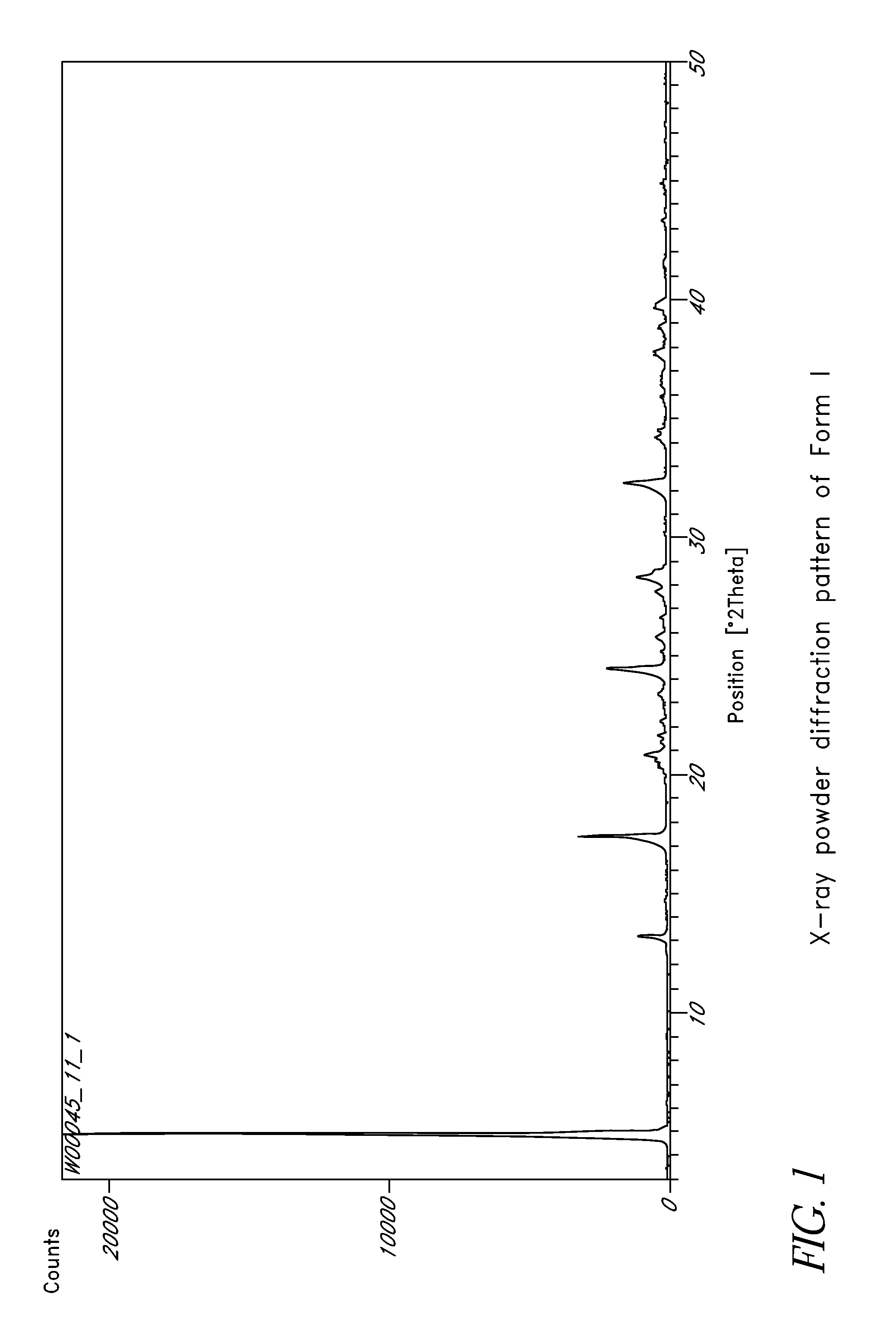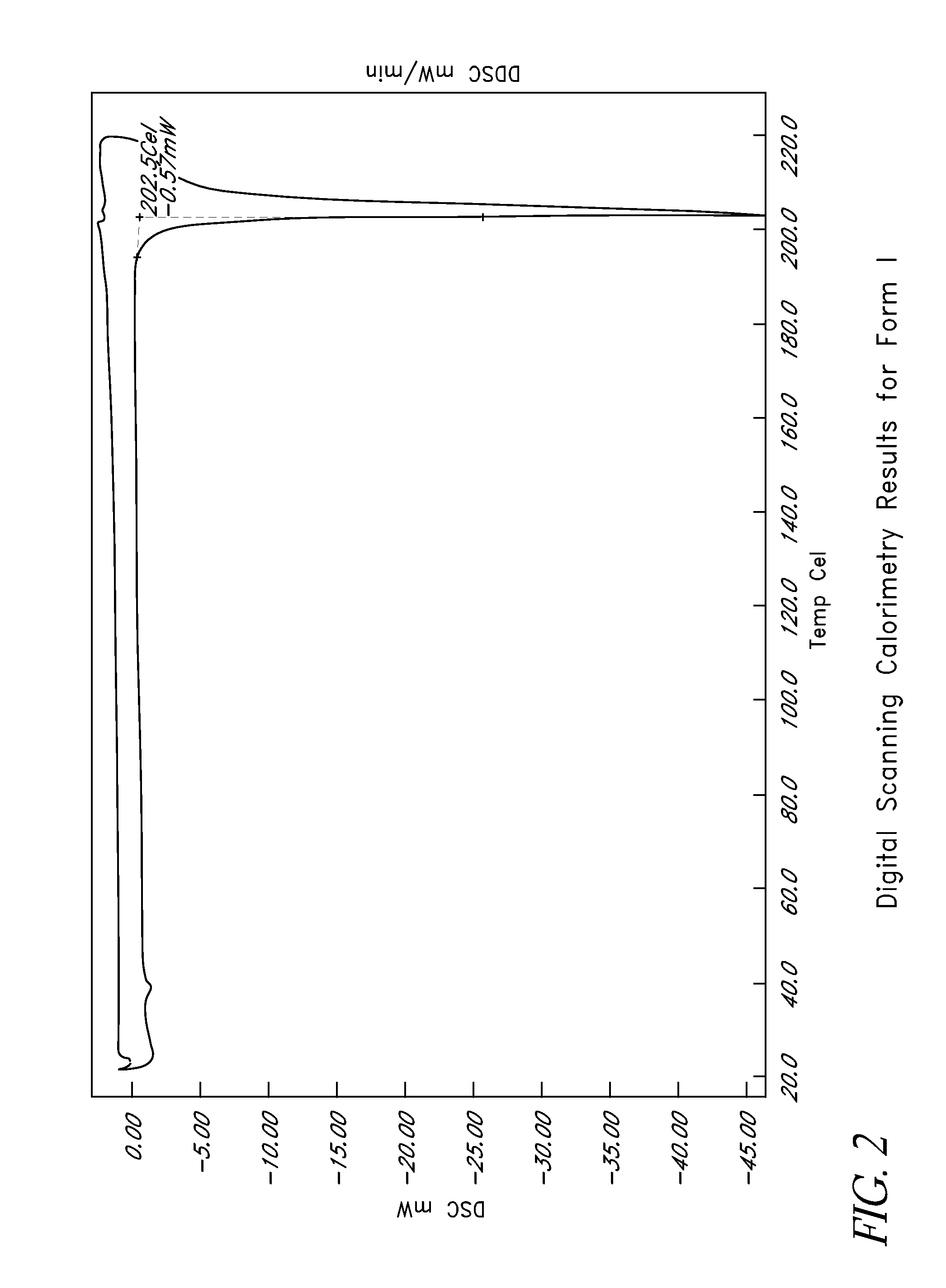L-ornithine phenyl acetate and methods of making thereof
a technology of phenyl acetate and ornithine phenyl acetate, which is applied in the field of lornithine phenyl acetate salts, can solve the problems of high sodium intake of cirrhosis patients, complicated acute or chronic hepatic failure, and undesirable salts,
- Summary
- Abstract
- Description
- Claims
- Application Information
AI Technical Summary
Benefits of technology
Problems solved by technology
Method used
Image
Examples
example 1
Precipitating Crystalline Forms
[0199]Saturated solutions of L-ornithine phenyl acetate were subjected to temperature cycling, crash cooling, evaporation, or anti-solvent addition as described above. The precipitate was analyzed by PLM and XRPD to determine the crystalline form (if any). The results are summarized in TABLE 5.
[0200]Six unique crystalline forms were identified from the precipitation studies, Forms I-VI. However, Forms IV and VI were obtained from solutions of acetic acid, and NMR results confirmed these forms to be L-ornithine acetate. Meanwhile, Tests 540-611 utilized samples of L-ornithine phenyl acetate originally isolated by the addition of ethanol anti-solvent. Many of these example produced Form I, which is an ethanol solvate, and therefore it is believed these samples originally included residual ethanol. Consequently, Form I may not be reproduced for certain conditions if the original sample does not include residual ethanol.
[0201]
TABLE 5Examples of Preparing C...
example 2
Intrinsic Dissolution Studies
[0202]The intrinsic dissolution rates for Forms I, II, and III were measured at pH conditions of 1.0, 4.5 and 6.7. The results are reproduced below in TABLE 6. In each case, complete dissolution was achieved in less than 3 minutes. Surprisingly, a pH dependence was observed for Form II; with the intrinsic dissolution rate increasing with the pH. In contrast, Forms I and III appear to dissolve at rates independent of pH.
[0203]
TABLE 6Calculated Intrinsic Dissolution Rates (mg / cm2 / s)1.04.56.7Form I0.410.440.37Form II0.260.340.62Form III0.490.440.45
example 3
Solubility Studies
[0204]The solubility of L-ornithine phenyl acetate was approximated according to methods disclosed above. 24 solvents systems were tested: 1,4 dioxane, 1-butanol, ethanol, acetone, benzonitrile, cyclohexane, DCM, DMSO, EtOAc, Heptane, IPA, IPA (1% H2O), MeCN, MeCn (1% H2O), MEK, MeOAc, methanol, MIBK, Nitromethane, THF, THF (1% H2O), Toluene and water. L-ornithine phenyl acetate exhibited a solubility in water, whereas L-ornithine phenyl acetate was substantially insoluble in the remaining solvent systems.
[0205]Slurries of L-ornithine phenyl acetate in water were also prepared and the slurry was filtered. The filtrate concentration was analyzed by HPLC, and the results show the solubility of L-ornithine phenyl acetate to be about 1.072 mg / mL.
[0206]HPLC determinations of solubility were also completed for five solvents: ethanol, acetone, methanol, DMSO and IPA. These results are summarized in TABLE 7.
[0207]
TABLE 7HPLC Solubility DeterminationsSolubilitySolvent(mg / mL...
PUM
| Property | Measurement | Unit |
|---|---|---|
| Angle | aaaaa | aaaaa |
| Angle | aaaaa | aaaaa |
| Angle | aaaaa | aaaaa |
Abstract
Description
Claims
Application Information
 Login to View More
Login to View More - R&D
- Intellectual Property
- Life Sciences
- Materials
- Tech Scout
- Unparalleled Data Quality
- Higher Quality Content
- 60% Fewer Hallucinations
Browse by: Latest US Patents, China's latest patents, Technical Efficacy Thesaurus, Application Domain, Technology Topic, Popular Technical Reports.
© 2025 PatSnap. All rights reserved.Legal|Privacy policy|Modern Slavery Act Transparency Statement|Sitemap|About US| Contact US: help@patsnap.com



